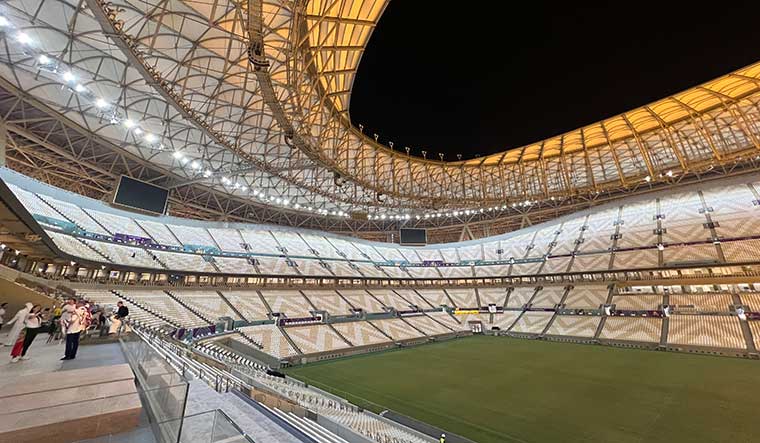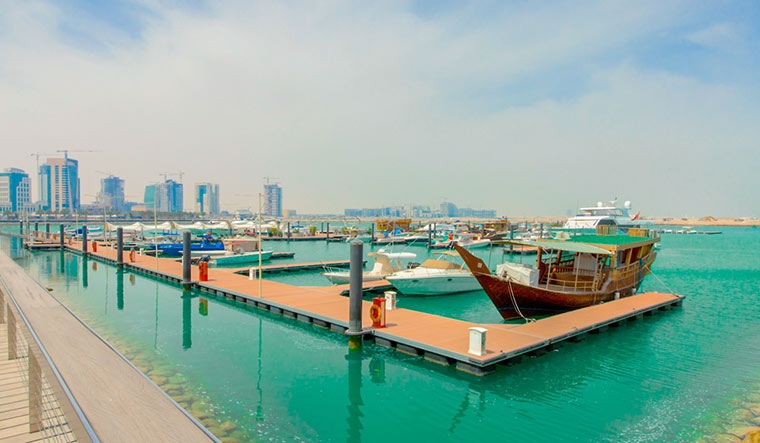QATAR IS LIT up like a bride’s home. And, much like in a bridal home, everyone is busy with preparations. They only have time for a hurried greeting or a polite word. So, if you head to Qatar early, the best thing to do is to take in the sights and sounds before the November rush. The most spectacular sights are the new stadiums—chief among them is the Lusail Stadium, the venue for the World Cup finals.
Lusail City has been termed by some as a new city built for the World Cup. But, it is a significant site in Qatari history. In the early 1900s, the founder of modern Qatar, Sheikh Jassim bin Mohammed Al Thani, ruled from the Founder’s Fort in Lusail settlement. The name Lusail pays homage to the rare al wassail plant which is native to the area.
The modernisation of Lusail, which is 23km from Doha, began in 2005. Qatari Diar, a state-controlled developer, is executing the project. The planned city has an area of 38sqkm and includes four islands. It boasts a marina, a palm-lined promenade, an integrated public transport system, 75km of cycling and walking routes, and 22 hotels with international star ratings. Notably, in 2021, Lusail hosted Qatar’s first Formula 1 Grand Prix. When finished, it can host two lakh residents, 1.7 lakh professionals and 80,000 visitors.
Incidentally, the Lusail Stadium also has a capacity of 80,000. As you walk in to what seems like an airport lounge or the lobby of a five-star hotel, you are welcomed by a cool breeze—Qatar’s indigenous cooling technology, which combines insulation with “spot cooling” (cooling only places with people). The system, which also draws back the cool air, re-cools and filters it, and pushes it out again, is said to be 40 per cent more sustainable than existing methods.
The aim is to maintain the temperature between 21 degrees and 24 degrees Celsius. If the temperature drops—it can be 12 degrees Celsius or lower in December—the system can increase the heat to maintain it in the desired range. Also, each seat at the Lusail Stadium has an air blower to ensure the comfort of every spectator. There are five large hospitality lounges and VIP and VVIP lounges as well as 100 sky boxes.
“The stadium is a 100 hectare site,” Tamim El Abed, the stadium operations manager, told THE WEEK. “The seating capacity [can be] 85,000; the minimum net capacity is 80,000. This means 80,000 seats having an uninterrupted view of the field. “You don’t have to ever stand up, move, push, look around the pillar.... Sit in your seat and watch the entire game, with very high quality of viewing.”
It took five years to build the venue, which received a five-star rating for sustainable building practices. It was completed in late 2021 and hosted its first game in August—a test event with 20,000 fans. A full-capacity match was held in September. THE WEEK visited the stadium on September 25 and learned that the turf would be changed ahead of the World Cup. This is because the grass had dried; the seeds were summer seeds. The new turf will use grass grown from winter seeds. These seasonal seeds are the result of eight years of research and ensures immunity to the climate and diseases.
Seeds for the turf as well as the trees and plants around the eight stadiums and 41 training centres were supplied by the Supreme Committee’s nursery in Al Khor. The 8.8 lakh sqm nursery, which uses treated sewage water, has grown over 16,000 trees of 60 species and 6.7 lakh bushes, till date. Turf seeds were developed jointly with a sports turf research institute based in the UK and tree offshoots were brought from Thailand, China, Columbia, Egypt, Spain, Argentina, Australia and India (banyan and bodhi trees from Surat, Gujarat).
While the sustainability features and green cover are impressive, the focus on legacy could bring more immediate benefits. The Lusail Stadium, for instance, will be transformed into a community hub post the World Cup, with affordable housing, schools, sporting facilities, shops and medical clinics. The stadium’s upper-tier will be repurposed into outdoor terraces for new homes, according to the SC, and materials removed will be donated to countries in need of sporting infrastructure.



